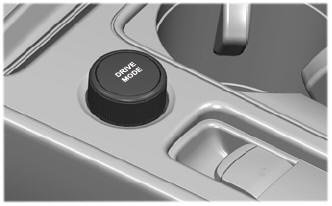Lincoln Corsair: Engine Cooling - 2.0L EcoBoost (177kW/240PS) – MI4 / General Procedures - Engine Cooling System Draining, Vacuum Filling and Bleeding
Special Tool(s) / General Equipment
 |
ROB75240 Coolant/Battery Refractometer (Fahrenheit) |
| Fluid Container | |
| Cooling System Vacuum Tester and Refiller | |
Draining
NOTICE: The coolant must be recovered in a suitable, clean container for reuse. If the coolant is contaminated, it must be recycled or disposed of correctly. Using contaminated coolant may result in damage to the engine or cooling system components.
NOTICE: Use the correct coolant. Do not mix coolant types. Mixing coolant types may degrade the coolant corrosion protection and may damage the engine or cooling system. For the correct coolant specified for this vehicle, refer to Specifications.
NOTICE: Always fill the cooling system with the manufacturer's specified coolant. Chemically flush the cooling system if a non-specified coolant has been used. Refer to Cooling System Flushing. Failure to follow these instructions may damage the engine or cooling system.
NOTE: During normal vehicle operation, coolant can change color. As long as the engine coolant is clear and uncontaminated, this color change does not indicate the engine coolant has degraded nor does it require the engine coolant to be drained, the system to be flushed, or the engine coolant to be replaced.
NOTE: Less than 80% of coolant capacity can be recovered with the engine in the vehicle. Dirty, rusty or contaminated coolant requires replacement.
-


Remove the pressure relief cap. WARNING:
When releasing the cooling system pressure, cover the coolant expansion tank cap with a thick cloth.
WARNING:
When releasing the cooling system pressure, cover the coolant expansion tank cap with a thick cloth.
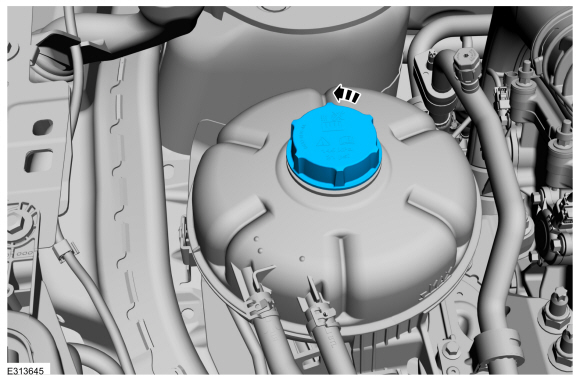 |
-
With the vehicle in NEUTRAL, position it on a hoist.
Refer to: Jacking and Lifting - Overview (100-02 Jacking and Lifting, Description and Operation).
-
Remove the retainers and the underbodyshield.
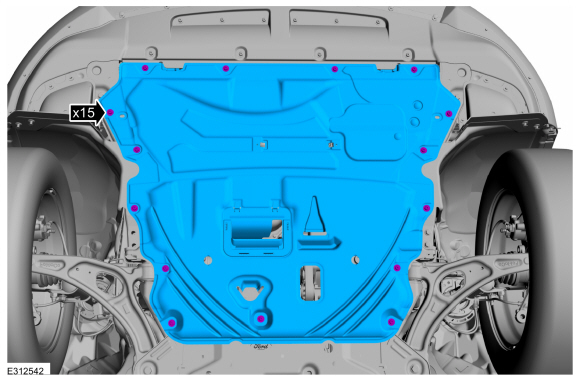 |
-

 WARNING:
Be prepared to collect escaping fluid.
WARNING:
Be prepared to collect escaping fluid.
-
Use a hose to drain the coolant.
-
Open the radiator drain valve and drain the engine coolant in a suitable, clean container.
Use the General Equipment: Fluid Container
-
Use a hose to drain the coolant.
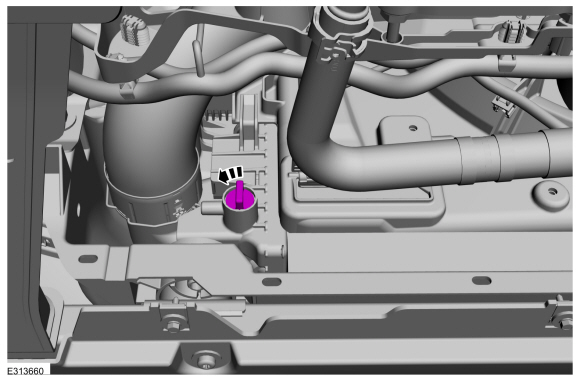 |
-
Close the radiator drain valve.
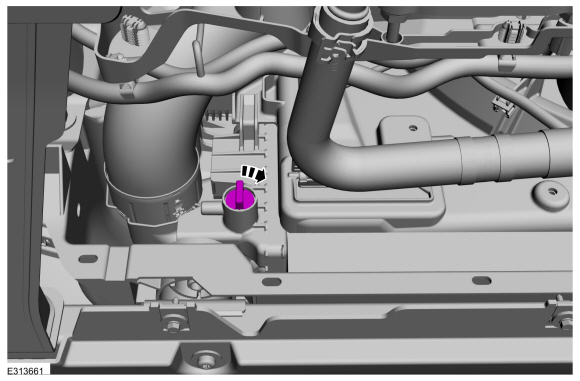 |
-
Install the engine underbodyshield and the retainers.
 |
Filling
-
NOTICE: Use the correct coolant. Do not mix coolant types. Mixing coolant types may degrade the coolant corrosion protection and may damage the engine or cooling system. For the correct coolant specified for this vehicle, refer to Specifications.
NOTICE: Engine coolant provides boil protection, corrosion protection, freeze protection, and cooling efficiency to the engine and cooling components. In order to obtain these protections, maintain the engine coolant at the correct concentration and fluid level in the degas bottle.
NOTICE: Do not add alcohol, methanol, or brine, or any engine coolants mixed with alcohol or methanol antifreeze. These can cause engine damage from overheating or freezing.
NOTE: Ford Motor Company does NOT recommend the use of recycled engine coolant since a Ford- approved recycling process is not yet available.
When adding or topping off the engine coolant:
-
Measure the coolant concentration in the vehicle.
Use Special Service Tool: ROB75240 Coolant/Battery Refractometer (Fahrenheit).
-
Determine the concentration desired based on the
vehicle duty cycle of extreme hot or cold operating conditions.
-
NOTICE: Make sure that the concentration of antifreeze is not below 40% or above 60% as engine parts could become damaged.
Add, top-off or adjust the coolant to the correct concentration.
Refer to: Specifications (303-03B Engine Cooling - 2.3L EcoBoost (199kW/270PS), Specifications).
-
Measure the coolant concentration in the vehicle.
-
Install the vacuum cooling system filler and follow the
manufacturer's instructions to fill and bleed the system.
Use the General Equipment: Cooling System Vacuum Tester and Refiller
-
Fill the degas bottle to the MAX FILL line.
-
Install the degas bottle cap until it contacts the hard stop.
-
Turn the climate control system off.
-
Start the engine and increase the engine speed to 3,500 rpm and hold for 30 seconds.
-
Turn the engine off for and wait for 1 minute to purge any large air pockets from the cooling system.
-
Check the engine coolant level in degas bottle and if necessary fill to the top of the MAX FILL line on the degas bottle. WARNING:
Always allow the engine to cool before opening the
cooling system. Do not unscrew the coolant pressure relief cap when the
engine is operating or the cooling system is hot. The cooling system is
under pressure; steam and hot liquid can come out forcefully when the
cap is loosened slightly. Failure to follow these instructions may
result in serious personal injury.
WARNING:
Always allow the engine to cool before opening the
cooling system. Do not unscrew the coolant pressure relief cap when the
engine is operating or the cooling system is hot. The cooling system is
under pressure; steam and hot liquid can come out forcefully when the
cap is loosened slightly. Failure to follow these instructions may
result in serious personal injury.
-
Start the engine and let it idle until the engine
reaches normal operating temperature and the thermostat is fully open. A
fully open thermostat is verified by the cooling fan cycling on at
least once.
-
If necessary, start the engine. Increase the engine speed to 3,500 rpm and hold for 30 seconds.
-
Allow the engine to idle for 30 seconds.
-
Turn the engine off for 1 minute.
-
Repeat steps 10 through 12 a total of 5 times to remove any remaining air trapped in the system.
-
Check the engine coolant level in degas bottle and if necessary fill to the top of the MAX FILL line on the degas bottle. WARNING:
Always allow the engine to cool before opening the
cooling system. Do not unscrew the coolant pressure relief cap when the
engine is operating or the cooling system is hot. The cooling system is
under pressure; steam and hot liquid can come out forcefully when the
cap is loosened slightly. Failure to follow these instructions may
result in serious personal injury.
WARNING:
Always allow the engine to cool before opening the
cooling system. Do not unscrew the coolant pressure relief cap when the
engine is operating or the cooling system is hot. The cooling system is
under pressure; steam and hot liquid can come out forcefully when the
cap is loosened slightly. Failure to follow these instructions may
result in serious personal injury.
-
Install the pressure relief cap.
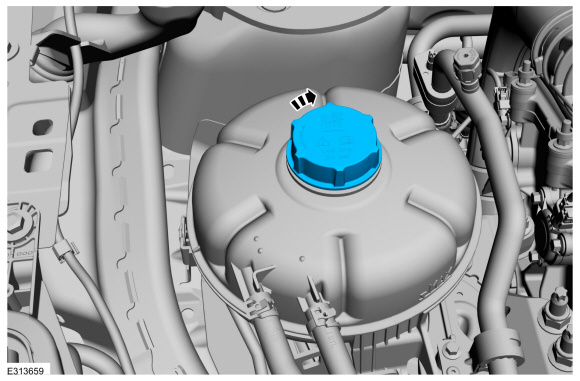 |
 Diagnosis and Testing - Engine Temperature
Diagnosis and Testing - Engine Temperature
Diagnostic Trouble Code (DTC) Chart
Diagnostics in this manual assume a certain skill level and knowledge of Ford-specific diagnostic practices. REFER to: Diagnostic Methods (100-00 General Information, Description and Operation)...
 General Procedures - Engine Cooling System Flushing
General Procedures - Engine Cooling System Flushing
Special Tool(s) /
General Equipment
ROB75240Coolant/Battery Refractometer (Fahrenheit)
Flushing
WARNING:
Always allow the engine to cool before opening the cooling
system...
Other information:
Lincoln Corsair 2020-2024 Service Manual: Removal and Installation - Fuel Rail Pressure (FRP) Sensor
Materials Name Specification Motorcraft® Silicone Brake Caliper Grease and Dielectric CompoundXG-3-A ESA-M1C200-AESE-M1C171-A Removal NOTE: Removal steps in this procedure may contain installation details. Release the fuel system pressure...
Lincoln Corsair 2020-2024 Service Manual: Description and Operation - Symbols Glossary
Symbols are used inside the graphics and in the text area to enhance the information display. Movement Symbols Movement symbols provide detailed information to a required component movement. These component movements can be rotational or 1-3 dimensional movements...
Categories
- Manuals Home
- 1st Generation Lincoln Corsair Owners Manual
- 1st Generation Lincoln Corsair Service Manual
- Fuel Quality - Gasoline
- Memory Function
- Head Up Display
- New on site
- Most important about car
Selecting a Drive Mode. DRIVE MODES
Selecting a Drive Mode
Note: Drive mode changes may not be available when the ignition is off.
